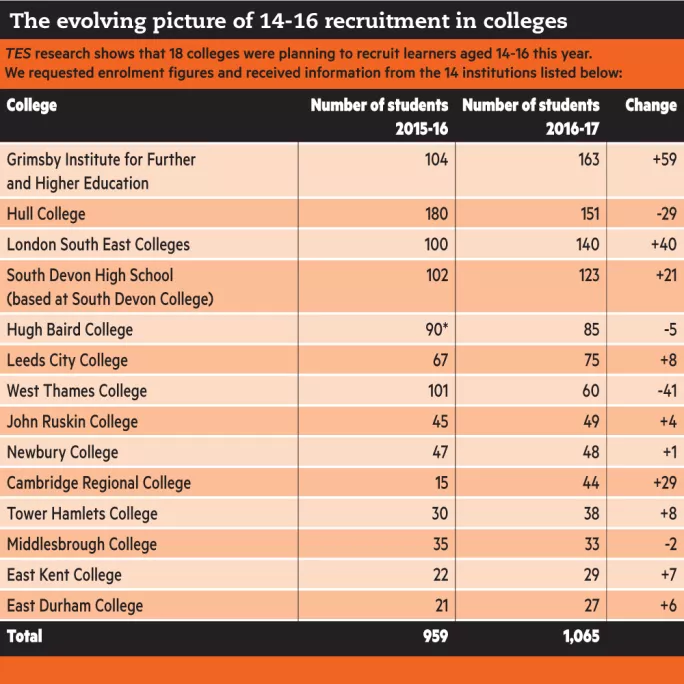Number of colleges taking on 14-16 students falls

When colleges were given the green light to recruit 14- and 15-year-old students in 2013, it was hailed as a game-changing moment for the sector.
But, for the first time since then, the number of colleges recruiting younger students has dropped, according to TES research. Overall enrolment rates across England have remained low, with the Association of Colleges (AoC) acknowledging the challenges of attracting younger students.
The number of colleges planning to recruit 14-16 learners in 2016-17 is just 18, down from the 20 that expressed their intention to do so last year. John Leggott College was the only institution intending to offer 14-16 provision for the first time this year.
Limited demand
Oldham College and Newcastle College confirmed that they had stopped taking on younger students in 2016-17, while Central Bedfordshire College scrapped plans to expand its age range last year. Newcastle College said it had ended its provision after enrolling only seven students in 2015-16.
TES contacted the 18 colleges planning to recruit 14-16 learners this year. In the institutions that supplied information, the overall number of 14-16 students enrolled increased slightly, from 959 last year to 1,065. But enrolment fell in four of the colleges.
These included Hull College, previously the institution with the biggest 14-16 provision. Its numbers dropped from 180 to 151.

Mike Hopkins, principal of Sussex Downs College - who chaired the 14-16 College Implementation Group set up after the Wolf report suggested colleges take on younger students - said he believed all 14-year-olds, regardless of their attainment in school, should be offered the option of a vocational pathway.
His college isn’t currently eligible to recruit from this age group, but he said he hoped to do so when that changed: “I am very keen on at least making the vocational offer available to all 14- to 16-year-olds.”
FE was an inclusive sector, Mr Hopkins added, but he could imagine the 14-16 offer being used by some schools to “get rid of their more difficult students”.
Oldham College principal Alun Francis told TES that his institution had decided to stop 14-16 provision as a strategic move in light of the ongoing reform of the sector, but also because it had not been possible to provide appropriate pathways for these students.
Many of the younger students recruited by the college were learners for whom “schools quite rightly were looking for a different solution”, he said. They were often in need of intensive behavioural and emotional support, and might have been better served in alternative provision.
“I thought we were letting students down,” Mr Francis explained, adding that colleges should focus on offering vocational pathways that were of equal standing to academic pathways in schools.
“When we start doing this again, it will be around proper high-quality qualifications for students who know what they might want to pursue a career in,” he said.
‘Strategic’ decision
Central Bedfordshire College said it had changed its mind over recruiting younger learners. “We do not offer full-time 14-16 provision,” a spokesperson said. “There were plans, but it did not start last year. It is, strategically, not something we are looking to do at the moment.”
In 2013-14, just four out of the 283 eligible colleges started taking on 14-16 students, with only 173 learners on their books between them.
The number of colleges increased to 14 the next year, with six more following in 2015-16. But 2016-17 is the first year in which the number of participating colleges has dropped.
This year, Grimsby Institute of Further and Higher Education is the biggest 14-16 recruiter, with the number of students increasing from 104 in 2015-16 to 163.
‘With the right vision and approach, FE providers can deliver successfully to this age group’
Debra Gray, principal of the Grimsby Institute Group, said: “The students get a full GCSE curriculum, plus hands-on vocational learning in an extended day and in class sizes of no more than 18. This has massive appeal to young people who need a different type of environment but is also highly aspirational for parents who recognise that smaller class sizes lead to better GCSE results.
“We now have over 250 young people at the academy and a waiting list for next September. It is a real success story. It also proves that with the right vision and approach, FE providers can deliver extremely successfully to this age group.”
Catherine Sezen, the AoC’s 14-19 policy manager, said colleges had to think very carefully about whether recruiting young learners met their strategic objectives.
There are challenges around taking on 14-16s, she said: “Often, it is young people who have not been successful in school, because maybe they haven’t fitted in or they have a passion for music or engineering, which maybe wasn’t met in the school context.
“The cohorts are fairly small, but possibly that is one of the strengths. Each provider interprets their provision to meet the needs of their learners and their college context. So there is no one approach that works for everyone. I think there may be questions over viability in terms of funding.”
You need a Tes subscription to read this article
Subscribe now to read this article and get other subscriber-only content:
- Unlimited access to all Tes magazine content
- Exclusive subscriber-only stories
- Award-winning email newsletters
Already a subscriber? Log in
You need a subscription to read this article
Subscribe now to read this article and get other subscriber-only content, including:
- Unlimited access to all Tes magazine content
- Exclusive subscriber-only stories
- Award-winning email newsletters